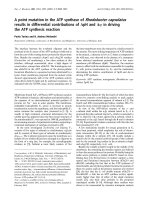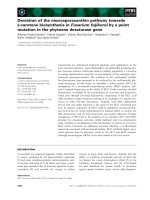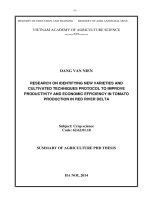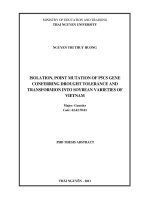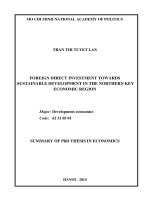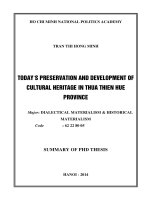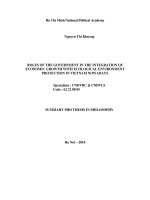PHD thesis abstrac isolation, point mutation of P5CS gene conferring drought tolerance and transformion into soybean varieties of vietnam
Bạn đang xem bản rút gọn của tài liệu. Xem và tải ngay bản đầy đủ của tài liệu tại đây (1.81 MB, 21 trang )
MINISTRY OF EDUCATION AND TRAINING
THAI NGUYEN UNIVERSITY
NGUYEN THI THUY HUONG
ISOLATION, POINT MUTATION OF P5CS GENE
CONFERRING DROUGHT TOLERANCE AND
TRANSFORMION INTO SOYBEAN VARIETIES OF
VIETNAM
Major: Genetics
Code: 62.42.70.01
PHD THESIS ABSTRACT
THÁI NGUYÊN - 2011
PUBLICATIONS
1. Nguyen Thi Thuy Huong , Chu Hoang Mau, Ha Tan Thu, Dinh Thi Kim Phuong,
Tran Thi Truong (2006), “Collection, classification, and qualitative assessment
of some local soybean cultivars in Sonla province, Science & Technology
Journal of Agriculture & Rural development, 11 (1): 28-32.
2. Chu Hoang Mau, Nguyen Thi Thuy Huong (2006), “Amino acid content and
drought tolerance of some local soybean variables in Sonla province ”, Science
& Technology Journal of Agriculture & Rural development, 20 (2): 22-26.
3. Nguyen Thi Thuy Huong, Chu Hoang Mau, Le Van Son, Nguyen Huu Cuong, Le
Tran Binh, Chu Hoang Ha (2008), "Evaluation of drought tolerant ability and
cloning of P5CS gene of some soybean cultivars (Glycine max L.Merrili)",
Journal of Biotechnology, 6(4): 459-466.
4. Nguyen Thi Thuy Huong, Tran Thi Ngoc Diep, Nguyen Thu Hien, Chu Hoang Mau,
Le Van Son, Chu Hoang Ha (2009) "The development of in vitro regeneration
system from cotyledonary node for transformation in soybean (Glycine max
L.Merrili) ", Journal of Science and Technolog, Thai Nguyen University 52(4):
82-88.
5. Nguyen Thi Thuy Huong, Chu Hoang Mau, Le Van Son, Nguyen Huu Cuong, Le
Tran Binh, Chu Hoang Ha (2009), "Mutagenesis of the P5CS cDNA to obtain
an enzyme insensitive to proline feedback inhibition". Bio-Hanoi 2009: 191
- 193.
6. Nguyen Thi Thuy Huong, Chu Hoang Mau, Le Van Son, Nguyen Huu Cuong, Chu
Hoang Ha (2010), "Cloning and activity evaluation of desiccation-inducible
promoter, RD29A from Arabidopsis thaliana ", Journal of Biotechnology
8(4): 1805-1810
7. Nguyen Thi Thuy Huong, Chu Hoang Mau, Le Van Son, Nguyen Huu Cuong, Chu
Hoang Ha (2010), "Removal of feedback inhibition of P5CS results in increase
proline accumulation and protection from drought stress on tobacco transgenic.
Bio-Hanoi 2010. Journal of Biotechnology, 8 (3A): 539-544.
8. Chu Hoang Mau, Nguyen thi Thuy Huong, Nguyen Tuan Anh, Chu Hoang Lan,
Le van Son, Chu Hoang Ha ( 2010) Characteristic of the gene encoding pyrroline
– 5 – carboxylate synthase (P5CS) in Vietnamese sobean cultivar (Glycine max
L.Merrill) 2010 International Conference on Biology, Environment and
Chemistry (ICBEC 2010) IEEE: 319-323
1
INTRODUCTION
1. Preface
Soybean (Glycin max L Merrill) is one of the most important crops not only in
Vietnam but also in other contries in the world. The soybean of Vietnam and other
world-leading producting coutries in the world is seriously affected by drought
annually. Soybean has low resistance to drought as well-documented so far in many
genotypes. In Vietnam, scienctists have succeeded in creating new varieties with
improved tolerace to drought through traditional breeding and these varieties are
widely cultivated in many areas. However, the traditional breeding itself possesses
disadvantages such as laboriousness, time spending, requiring enough hybrids and
unstability. The developments of modern biotechnology can overcome these
disadvantages of conventional methods. On of the well-known technology is plant
transformation mediated by Agrobacterium tumefaciens successfully applied in
varied plant crops by breeding scientist in the world. The research group of Dr. Tran
Thi Cuc Hoa at the Cuu Long Delta Institute of Rice Research has recently reported a
transformation system for soybean and the system is applied to produce novel
soybean varieties with resistant to differenct pathogens. Despite this fact, the
application of plant transformation for developing soybean with modified stress
tolerance has not been used domestically.
Based on above arguments we performe a work entitled “Isolation, point
mutation of P5CS gene conferring drought tolerance and transformation into
soybean varieties of Vietnam”.
2. Objectives
2.1. Comparing the DNA sequence of P5CS isolated from different soybean varieties
and producing mutant P5CS without feedback inhibition by proline.
2.2. Designing transformation vector carrying mutant P5CS conferring drought
tolerance in soybean.
2.3. Creating transgenic soybean containing the transformation vector carrying
mutant P5CS.
3. Activities
3.1. Characterization of biochemical and physiological features of soybean varieties
grown in the North of Vietnam.
3.2. Isolating and sequencing gene encoding for 1-pyroline-5 carboxylate synthetase
(P5CS).
3.3 Site-directed mutagenization of P5CS in order to remove the feedback inhibition
by proline.
2
3.4. Isolation of promoter rd29A – a responsive promoter under dehydration
conditions – from Arabidopsis thaliana and characterization of promoter rd29A in
transgenic tobacco.
3.5. Construction of vector carrying P5CS under the control of promoter rd29A and
transformation of this construct into tobacco.
3.6. Characterization and analysis of drought tolerance transgenic tobacco lines under
stress conditions in vitro.
3.7. Transformation of the construct carrying P5CS under the control of promoter
rd29A into Vietnamese soybean and analysis of the present of P5CS in transgenic
lines.
4. Significant results
4.1. Gene P5CS was successfully isolated and sequenced from two Vietnamese
soybean varieties, DT84 and SL5, respectively, with 2148 nucleotides in length and
encoded for a protein with 715 amino acids.
4.2. The feedback inhibition by proline of enzyme P5CS was successfully removed
using site-directed mutagenesis at the 125
th
amino acid (Aspartate into Alanine).
4.3. Promoter rd29A was successfully isolated from Arabidopsis thaliana with 1298
nucleotide in length carrying typical element of a responsive-dehydration promoter
such as MYB, DRE, AMYBOX.
4.4. The vectors carrying GUS and P5CSM under the control of promoter rd29A were
constructed and transformed into tobacco. The transgenic tobacco lines containing
construct rd29A::GUS showed significant enhancement in enzyme activity of GUS
under stress conditions. Moreover, the transgenic tobacco lines containing construct
rd29A::P5CSM represented significantly higher resistance to drought in comparison
with the wildtype plants. The results confirmed a fact that this construct can be
reasonably used for other crops and plant species in order to create new plant
varieties with improved stress tolerance.
3
4.5. The transformation system into soybean was optimized and used to create
transgenic soybean lines containing construct rd29A::P5CSM. These lines were
positively analyzed by PCR and will be good materials for further researches on
developing new soybean varieties with high resistance to drought.
5. Scientific and applied values
5.1. Scientifically, this is the first report in Vietnam on determining the tolerance of
varied soybean varieties under artificial stress conditions, isolating and modifying the
structure of P5CS by site directed mutagenesis by PCR. The results on analysis of
P5CS confirm the fact that the difference in drought tolerance in soybean is
determined by complicated mechanism, however P5CS is one of the most important
factors conferring the drought tolerance in crop in general.
5.2. Practically, the results on analysis of transgenic soybean plants containing the
mutant P5CS under the control of stress inducible promoter rd29 proved the practical
values of the thesis.
The drought tolerance in transgenic tobacco containing this structure show that this
can be applied on other crops in order to improve one the most vital trait of crop,
drought. The results on establishing the transformation system in soybean are the
valued basis for further developing novel soybean varieties with high stress tolerance.
6. Structure of the thesis
The thesis includes 113 pages, divided by parts as following: Introduction composes
3 pages; Chapter 1: Overview, 34 pages; Chapter 2: Materials and Methods, 15
pages; Chapter 3: Result and discussion, 46 pages; Outlooks, 2 pages; Publication: 1
page; References: 11 pages; The thesis included 29 tables, 43 figures and 118
references in English and Vietnam.
Chapter 1. OVERVIEW
The thesis cited and sumarized 64 publications, among these 10 were written in
Vietnam, 51 were written in English, 3 websites about 5 basic subjects such as: (1)
introduction of soybean (Glycine max (L.) Merill), economic and practical values; (2)
4
Physiological and biochemical basics of drought tolerance in soybean; (3) Proline and
the improtant function of P5CS in the proline biosynthesis in plants; (4) Promoter and
roles in controlling the expression of genes under drougth conditions; (5) Studies on
improving the drought tolerance of soybean in the world.
Proline is known as one of the compounds functioning in osmotic regulation
mechanism of plant cell under stress conditions such as drought, salinity (Delauney
and Verma, 1993). Beside that, proline plays vital roles in protecting cellular
structures and macro molecules when the cell is under osmotic stresses; in protecting
protein structure and improving the activity of varied enzymes; in digesting reactive
oxygen residues and in inactivating singlet oxygen quencher (Szavados et al, 2009).
In plants, the biotesynthesis of proline is controlled by two genes encoding for P5CS.
These two genes are highly homologous in amino acid sequence but expressed
differently under different conditions. Both genes are found to express in flower in order
to provide proline for the flower development processes (Mattioli et al, 2009). The study
on Arabidopsis showed the tight relationship between the expression of these two genes
and the accumulation of proline when plants are exposed to salinity condition; and the
feedback inhibition by poline on P5CS is also affected under the same conditions. The
transgenic tobacco overexpressed a mutant P5CS which lost this inhibition showed that
the accumulation of proline increase up to two folds in comparison to wildtype.
Recently, a P5CS has been isolated from rice and when transformed back into rice
revealed that transgenic plants showed higher tolerance to salinity and cold.
Promoter rd29A is an inducible sequence under varied conditions such as
drought, salt and cold. Studies found important motifs in rd29A sequence related to
the operation such as ABRE and (DRE)/C repeat (CRT). These two motifs are
thought to be important for rd29A in order to control the expression of genes under
stress conditions of surrouding environment (Yamaguchi-Shinozaki và Shinozaki,
1993). Rd29A has been isolated from many plant species such as Arabidopsis,
tobacco and rye (Sun và Chen, 2002). The transformation vectors bearing GUS under
the control of rd29A have been transformed into potato and sugarcane. The activity of
5
GUS has been found in transgenic plants under different stress conditions in culture
(Zhang et al., 2005) .
In therory, there are different methods for improving the stress tolerance in
plants, however the application of transformation technology is more preferable with
breeding scientist. For Vietnam, there is no doubt about the high potential of
application this technique in developing new crop varities with improve drought
tolerance.
Chapter 2. MATERIALS AND METHODS
2.1. Materials, chemicals and equipments
Plant materials: 16 local and DT 84 soybean varieties ; 326 tobacco variety
(Nicotiana tabacum), and Arabidopsis thaliana.
Chemicals: pBT clone vector, pBI101 vector for contructing a transgenic vector, pTN
289 transgenic vector. Primers for amplifying the P5CS gene and the rd29A promoter
were designed based on the nucleotide sequence of P5CS gene (Genebank code:
AY492005) and the nucleotide sequence of the rd29A promoter (Genebank code:
AB428730). The chemicals for tissue culture and bio-molecular experiments
belonging to Merk, Bioneer, Fermentas were supported by Plant Cell Biotechnology
Department.
2.2. Methods
2.2.1. Bio-physical and bio-chemical methods
- The ability of drought tolerance was rapidly estimated following Binh L. T. et. al.
1998
- The dissolved protein concentration was determinated by Lowry’s method. Amount
of lipids was determinted following Chau P. T. T. Amount and components of amino
acids of seeds were determinted following Chi P. V. et al. (1997).
- Prolin concentration was determinted following Bates et. al. (1973).
- Data was analyzed following Tuat N. H. and Khoi N. K. (1996).
2.2.2. In vitro tissue culture methods
6
In vitro tissue culture methods on Arabidopsis and tobacco are following
Topping ,1988. Soybean plants were generated by the multiple-shooting system
using axillary cotyledon of matured seeds. The transgenic protocol using axillary
cotyledon of matured seeds was improved from Olhoft’s method (2001).
2.2.3. Bio-molecular methods
- Specific primers were designed based on nucleotide sequences on Genebank.
- The total DNA was isolated from arabidopsic and tobacco leaves;
- The total RNA was isolated from soybean using Trizol Regents kit (Invitrogen)
- cDNA was synthesized by using Total RNA and RevertAid
TM
H Minus First Strand
cDNA Synthesis Kit (Fermentas).
- PCR reaction: P5CS gene was amplified by using specific primers. The PCR reaction
consisted of 94
0
C for 5 minutes, then 35 cycles of 94°C for 30 seconds, Tm (from
50
0
C to 62
0
C) for 45 seconds, and 72°C for 60 seconds, followed by a final extension
of 72°C for 10 minutes.
- OE - PCR reaction( Overlap Extension-PCR)
OE-PCR reaction was carried out following: 94ºC for 5 minutes; then 4 cycles of 94ºC
for 30 seconds, T
m
(from 50
0
C to 62
0
C) for 45 seconds, 72ºC for 90 seconds; 72ºC for
10 minutes, followed by a final extension of 72°C for 10 minutes. Then, the products
were placed immediately on ice and 1µl BamHI and 1µl SaclI. The OE-PCR reactions
were continued following 94ºC for 5 minutes; then 30 cycles of 94ºC for 30 seconds,
T
m
(from 50
0
C to 62
0
C) for 45 seconds, 72ºC for 90 seconds; 72ºC for 10 minutes,
followed by a final extension of 72°C for 10 minutes.
- Cloning methods: recombined plasmids were isolated and purified following
Sambrook et. al. (2001) and Plasmid Miniprep Kit (Qiagen). Cutting by restricted
enzymes was done following Sambrook et. al. (2001)
- Colony-PCR method.
- Constructing vectors: rd29A :: GUS và rd29A :: P5CSM
- Transgenic plant analysis methods: the present of inserted gene in transgenic plants
was identified by bio-chemical methods. Transgenic tobacco plants were treated
7
drought artificially by using PEG following Jun et. al. (2001). The concentration of
beta-glucuronidase (GUS) was determinated following Tefferson et. al. (1987)
Chapter 3. RESULTS AND DISSCUSION
3.1. Results in collection and evaluation of local soybean varieties in Son La
province
3.1.1. Characteristics of morphology and biochemistry
Sixteen soybean varieties were detected in seven counties in 11 different districts of
Son La province. Protein content of these varieties ranged between 29.72% -52.75%
protein / dry weight and lipid content ranged from 9.9% - 18.65% in which DT84
varieties have the highest lipid content 18.65%, followed by SL3 (17.34%).
3.1.2. Analysis of drought tolerance ability of soybean varieties.
Proline content of SL5 increased up to 377.44% (highest value) after 9 days of
drought treatment. Whereas proline content of DT84 increased slightly at all three
time points (101.06, 129.26 and 146.81%). This result is consistent with the other
studies when they research on drought tolerace of different crops such as rice
(Nguyen Huu Cuong et al; Due et al; Choudhary et al 2005), legumes (Curtis et al;
Chen et al).
3.2. Cloning of P5CS and elimination of reverse inhibition by site-directed mutation
3.2.1. Cloning of P5CS
3.2.2. Results in amplification, cloning and sequencing of P5CS gene
Total RNA was extracted and cDNA was synthesized from SL5 and DT84. Four
nucleotide fragments of P5CS gene were amplified by PCR and checked by
electrophoresis on 0.8% agarose gel. Figure 3.3 showed that the size of the gain band
corresponding to the size of the theoretical calculations. In order to obtain full
sequence of P5CS gene, these two PCR products were mixed and used as template
for PCR using primers P5CSfor/P5CSrev. PCR products obtained approximately
2100 bp in size (Figure 3.4).
8
Figure 3.3. PCR amplification of two
P5CS nucleotide fragments of DT84 and
SL5
1, 3: DT84; 2, 4: SL5; M: 1 kb DNA
ladder
Figure 3.4. Combination of two P5CS
nucleotide fragments by PCR 1, 3:
DT84; 2, 4: SL5; M: 1 kb DNA ladder
Sequencing results showed that the nucleotide sequences of both two samples (DT84
and SL5) contain 2148 nucleotides encoding 715 amino acids. In which two amino
acid Asp125 and Phe128 in the deduced P5CS amino acid sequence cause inhibition
of P5CS activity by increasing proline content in cells (Zhang et al 1995)
2
Figure 3.10. Identification of P5CS by
PCR with P5CS M125for2/SacI-P5C
primer pair (1) and P5CS for / P5CS rev
primer pair (2); M : 1kb DNA ladder.
Figure 3.11. Combination of two DNA
fragments following OE-PCR method
using BamHI-P5CS and Sacl-P5CS
primer pair. A, B : 1+2, M: 1kb DNA
ladder
2100bp
M
2
1
1800bp
400bp
1000bp
1500bp
M
A
B
M 1 2 3 4
2100bp
M 1 2 3 4
9
3.2.3. Results in elimination of reverse inhibition by site-directed mutation of P5CS
Figure 3.10 showed that the size of obtaining DNA fragment was about 2100 bp,
which corresponds to the original size of the P5CS gene (Fig. 3.11).
However, in order to check whether the cloned P5CS contains the nucleotide
exchange mutation (A T) at nucleotide position 374 of P5CS gene, the cloned P5CS
was sequenced and showed in Fig. 3.13.
310 320 330 340 350 360 370 380
| | | | | | | | | | | | | | | |
MSL5 AACAGCCTTATGGCTCTTTATGATGTTTTGTTTAGTCAGCTGGATGTGACATCTGCTCAGCTTCTTGTGACGGCCAATGA
N S L M A L Y D V L F S Q L D V T S A Q L L V T A N D
SL5 A
N S L M A L Y D V L F S Q L D V T S A Q L L V T D N D
Figure 3.13. Analysis of nucleotide sequence of the cloned P5CS and detection of
nucleotide exchange mutation
Nucleotide sequences of the cloned P5CS were aligned out by BioEdit 7 software.
The alignment showed that the nucleotide A at position 374 was replaced by
nucleotide C (A374→G), resulting in the change of one amino acid (Asp125→Ala)
in the deduced amino acid sequence.
3.3. Cloning and testing the activity of rd29A promoter after drought treament
3.3.1. Cloning of rd29A promoter
The primer pair rd29A -HindIII / rd29A -BamHI (Tab. 3.7) was designed according
to the nucleotide sequences of rd29A in Gene Bank and used to amplify the complete
sequence of rd29A promoter (1290 nucleotides) from A. thaliana genomic DNA.
Electrophoresis of PCR product showed that there was a single band of 1.3 kb.
10
Figure 3.15. Identification of rd29A in pBT/rd29A by PCR and restriction digestion
of pBT/ rd29A using BamHI/HindIII
M) Marker; 1) PCR product; 2) pBT/ rd29A digested with BamHI/HindIII
PCR products were ligated into pBT cloning vector and transformed into E. coli
DH5(α). The obtaining colonies after transformation were screened by colony-PCR
using specific primers and double enzyme digestion. Electrophoresis showed that the
DNA band of 1.3 kb equivalent to the expected size (1.29 kb). The results proved
PCR product was successfully ligated into pBT cloning vector (Fig 3.15).
3.3.2. Analysis of rd29A promoter nucleotide sequence
After checking the presence of Rd29A promoter by PCR and restriction
digestion, nucleotide sequence of rd29A was confirmed by sequencing using specific
primers. The obtaining nucleotide sequences were alignted out with nucleotide
sequence of rd29A deposited in Gene Bank. The aligntment result showed that rd29A
promoter was succesfuly cloned and consisted of 1290 bp in length. In which, there
are a few boxes that contain necessary sequences for regulated promoter activities
such as TATA box; CCAAT box – GC rich region (GGGCCAATAG), cap signal and
regions related to transcription (-10 và -35). In addition, regions related to drought
11
condition such as DRE, ABRE also were observed (Fig 3.16). This result is
consistent with findings of earlier studies (Wu et al 2008; Shinozaki et al 2007).
Furthermore, rd29A promoter isolated in this study also contains the cis elements of
the MYB group, DRE, AMYBOX. These cis elements were specific for the regulated
promoter which is activated under stress conditions such as drought,
salinitanddehydration.
gaatgagaaggatgtgccgtttgttataataaac
-10
agccacacgacgtaaacgtaaaatgaccacatgatgggccaatagacatggaccga
CCAAT box và vùng giàu GC
ctactaataatagtaagttacattttaggatggaataaatatcaTACCGACATcag
DRE-1
ttttgaaagaaaagggaaaaaaagaaaaaataaataaaagatatacTACCGACATg
-35 DRE-2
agttccaaaaagcaaaaaaaaagatcaagccgacacagacacgcgtagagagcaaaatgactttgacgtcacaccacga
aaacagacgcttcatACGTGTCcctttatctct
ABRE
ctcagtctctctataaacttagtgagaccctcctctgttttactcacaaatatgca
Cap signal TATA box
Aactagaaaacaatcatcaggaataaagggtttgattacttctattgga
Figure 3.16. Nucleotide sequence of rd29A promoter
3.3.3. Contruction of plant transformation vector carrying rd29A
In order to confirm the activity of rd29A promoter under drought condition, rd29A
was inserted into pBI101 and drove the expression of gus gene. The insertion of
rd29A promoter into pBI101 were check by PCR and restriction digestion using
BamHI and SacI. Fig. 3.18 showed that the DNA band of 1.3 kb equivalent to the
expected size. Then the binary vector pBI101/rd29A is transform into Agrobacterium
tumefaciens (strain C58) for plant transformation.
12
Figure 3.18. Identification of rd29A by PCR and restriction digestion of pBI101/
rd29A
M) Marker; 1-2) PCR products; 3-4) pBI101/ rd29A digested with BamHI/SacI
3.3.4. Production of transgenic tobacco containing transformation vector
rd29A::GUS
1. Explants on induction medium
GM after two days
2. Explant inoculated
with bacteritum
3. Explants on
cocultivation meidum
after two days
4. Explants on medium GM
supplemented 50mg/l Kanamycin
and 400mg/l Cefotaxime
5. Shoots on medium
GM supplemented
50mg/l Kanamycin and
400mg/l Cefotaxime
6. Transgenic plants on
medium RM
supplemented 50mg/l
Kanamycin and
400mg/l Cefotaxime
7. Transgenic plants in greenhouse
8. Transgenic plants
grown in soil
9. Transgenic plants
grown in greenhouse
Figure 3.19. Transformation of rd29A into tobacco
13
Analysis of activity of promoter rd29A in transgenic tobacco
After transformation, 51 transgenic tobacco line were produced on regeneration medium
containing kanamycin. Screening 22 lines by PCR using specific primer for rd29A -
HindIII/ rd29A –BamHI showed that 21 of tested lines contained interseted gene rd29A.
To analyse the activity of GUS, 3 of 21 positively PCR-sreened lines were choosen and
used for drought stress by artificial condition using 10% PEG (polyethylene glycol). The
results showed that under dehydration the activity of GUS in transgenic tobacco lines
were clearly identified and strong incomparison to wildtype and untreated other
transgenic lines (Figure 3.20).
0
100
200
300
400
500
600
700
800
DCT DCS 3T 3S 4T 4S 5T 5S
Mẫu
L ượ n g M U (p m o l/ m i n . m g )
Figure 3.20. The expression of GUS in
transgenic plants
A: wildtype treated; B: Transgenic
plants untreated; C: The transgenic
plants treated after 24 hours.
Figure 3.21. The activity of GUS in
transgenic tobacco lines containing
promoter rd29A under artificial drought
conditions
ĐC: wildtype; 3, 4, 5: The transgenic
plants, T: before drought, S: after
drought.
The activity of GUS in transgenic tobacco lines were also analysed by the reaction
conversed the subtrated MUG. GUS oxides the substrate MUG into MU, the stronger
activity of GUS is, the more MU produces. MUS can be detected by spectrophotometer
at 378 nm (Fior et al, 2009). The amount of MU produced in transgenic tobacco lines
after stress was increased up to 13 folds (figure 3.21). The data in this thesis were in
agreement with reported by Zhang (Zhang et al, 2005).
14
3.4. Analyse the improvenment in drought stress tolerance of transgenic tobacco
containing rd29A:: P5CSM
3.4.1. Designing the transformation vector containing rd29A:: P5CSM
The results showed here was the digestion of P5CSM and rd29A::GUS by two
restriction enzymes BamHI and SacI. After ligation by T4 ligase and transformation
into competent cells.
A B
Figure 3.23. Electrophoresis of colony-PCR and digestion products of vector pBT
Results of digestion by restriction enzymes and colony-PCR (Figure 3.23 confirmed
that 3 colonies containing the transformed vector. This meant that we successfully
designed the transformation vector bearing rd29A:: P5CSM which were ligated in
pBT.
Results of transformation vector containing rd29A:: P5CSM into Agrobacterium
tumefaciens
Electrophoresis results were checked on gel agarose 0.8% and showed clearly that 4
of 9 colonies choosen revealed positive results by using PCR. The resutl showed an
unique band with about 1300bp in length. This firmly showed that the transformation
vector rd29A:: P5CSM was sucessfully transformed into Agrobacterium
tumefaciens. Therefore we have produced the Agrobacterium tumefaciens
containing pGV2260 bearing recombinant vector rd29A:: P5CSM. This is the
good material for further transformation in plants in order to create new
drought-tolerance varieties.
M 1 2 3 - +
A: Colony-PCR products using primer rd29A
for / rd29A rev
M: Ladder DNA 1kb; Giếng 1-3: Colonies
(-) negative control, (+ ) positive control
B: Digestion products by BamHI
and SacI
M: Ladder DNA 1kb; 1-3: Colonies
1.3kb
1 2 3 M
12kb
3,4kb
15
3.4.2. Production of transgenic tobacco carrying vector rd29A:: P5CSM
The transformation vector pBI101 bearing promoter rd29A controlling the expression
of P5CS was transformed into tobacco cultivar K326.
Figure 3.25. Screening transgenic tobacco lines PCR using primers rd29A for
/rd29Arev
M: Ladder DNA 1kb; 1-9Transgenic lines; (-) Negative control; (+) Postive control
Figure 3.25 showed that 30 of 33 putative transgenic tobacco lines were
positive after screening by PCR. Only one DNA band with 1.4kb in length was
revealed at each electrophoresis lane. This is the expected length of promoter rd29A.
This meant that these transgenic tobacco lines carrying expected transformation
vector rd29A:: P5CSM.
3.4.3. Analysis of the drought tolerance ability of transgenic tobacco lines
The samples of transgenic tobacco linew and wildtype were collected before and after
drought stress treatment 3, 5, 7 and 9 days. The samples were used to extract proline
and checked for the proline content. The results were showed in table 3.7 and figure
3.25. After drought treatment, the content of proline in studied plants was strongly
increased, especially in transgenic tobacco plants. After 9 days of stress treatment, the
content of proline was increased up to 206.8% in the wildtype and from 259.5 to
451.8% in transgenic tobacco plants (highest in lines H33 and lowest in H11).
M 1 2 3 4 5 6 7 8 9 - +
16
Figure 3.27. Transgenic tobacco plants after 20 days of drought treatment (A) and
recover (B)
WT: Wiltype, H11, H15, H26, H33: Transgenic plants
3.5. Results of production of transgenic soybean
3.5.1. Results on regeneration via multishoot of soybean variety DT84
3.5.1.1. Optimization of seed sterilization time
By comparison two methods of seed sterilization (by chloride gas and by
natrihypochloride) we found that chloride gas showed better results and the time
required for the sterilization was 16 hours, sterilized seeds were good for further
experiments.
3.5.1.2. Effect of BAP on the mutishoot regeneration from cotyledons
The samples were wounded and removed the shoot apex, were placed on 8 media
containing BAP with different concentration from 0mg/l to 2.5mg/l. Eventually we
found that the medium supplemented by 2mg/l BAP was the most suitable for
multishoot multiplication and was used for further experiment.
3.5.1.3. Effect of plant growth regulator GA
3
on shoot elongation of multishoot
Multishoots induced on medium SIM4 were transferred onto medium sumpplemented
by GA
3
with different concentration from 0.5, 1, 1.5mg/l. The addition of GA
3
(0,5 mg/l)
was the most suitable for shoot elongation and this is ingrement with other reports
previously (Olhoft et al 2007), Olhoft et al 2001)
17
3.5.1.4. Effect of IBA on root production
The concentration of IBA was studied and concluded that 0.1mg/l was the most suitable for
rooting in vitro of soybean cultivar DT84.
3.5.1.5. Identification of potting mix for cultivating transgenic soybean in
greenhouse
Potting mixtures including trấu hun, 1 burnt hustle: 1 sand and commercial mixture
were tested. The factors were taken into consideration were survival ratio and the
number of plants. The results showed that the mixture 1 burnt hustle: 1 sand was the
most suitable for cultivating in vitro plants under greenhouse conditions.
3.5.2. Results on transformation of GUS into soybean cultivar DT84
The transient expression of GUS was 67.5%. The number of survival samples on
selection medium was 15.21% after two weeks.
3.5.3. Results of transformation of drought-tolearnce vector into soybean
The experiments were repeated three times with 1262 explants used for
transformation. 564 samples were shooted, 101 shoots were elongated and during the
selection by antibiotics 28 were survived and rooted. These plants were grown in
greenhouse. To check for the presence of transgene in plants, after one month of
growing in greenhouse, leaves were harvested for DNA isolation and PCR screening.
The results showed that 3 plants were positive by PCR screening.
Figure 3.36. Screening transgenic plants by PCR
M: Ladder DNA 1kb; (-): Negative control; WT: Wildtype; 1 -4: Transgenic plants;
(+): Positive control
M 1 2 3 4 5 WT - +
18
Line 11 Line 23 Line 17
Figure 3.37. Transgenic soybean
CONCLUSION AND OUTLOOKS
1. Conclusion
1.1. Soybean varieties collected are varied in phenotype, size and the number of
seeds. Analysis of biochemical characteristics of local soybean varieties showed the
strong correlation between the quality and the drougth tolerance. The correlation
between the content of proline and the drought tolerance was proved in these studied
soybean varieties.
1.2. The sequences of P5CS isolated in two soybean varieties DT84 and SL5 were
2148 nuleotide encoded for 715 amino acids.
1.3. The gene P5CS was mutated at the amino acid 125 in soybean varieties SL5.
Asparated was replaced by alanine in protein sequence.
1.4. Promoter rd29A was succesfully isolated from Arabidopsis thaliana. Promoter
rd29A was 1298bp in length and carried typical motifs including MYB, DRE,
AMYBOX.
1.5. The operation of rd29A was analysed in transgenic tobacco. Under dehydration,
promoter rd29A controled the expression of GUS and GUS was strongly expressed in
transgenic tobacco plants in comparison to wildtype and untreated transgenic plants.
1.6. In transgenic tobacco carrying transformation vector rd29A:: P5CSM , the
increase in proline content was observed and these plants growed better and longer
19
under stress condtions compared to wildtype. The recover of transgenic plants after
treatment was obvisously better than the wildtype plants.
1.7. The transformation and regeneration systems were optimized for soybean.
Transgenic plants carrying vector rd29A:: P5CSM were produced in Vietnamese
soybean cultivar DT84, these were positively screened by PCR using specific
primers.
2. Outlooks
2.1. Further studies should be done for transgenic soybean lines in term of developing
novel soybean varieties with improved drougth resistance.
2.2. Using transformation vector rd29A:: GUS và rd29A:: P5CSM should be tested in
other crops .
